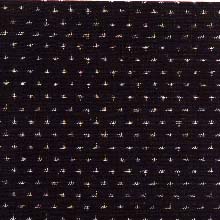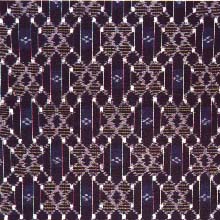Weave (p. 126 )
1. Produced in Kurume City Fukuoka Prefecture.
2. Characteristics: Most famous, high quality cotton "Kasuri." Kasuri patterns expressed with the light and shade of indigo and white are beautiful. The fabric looks naive and warm and most designs are geometrical patterns and small figures. One of the three famous Kasuri(Bingo, Iyo and Kurume).
3. Uses: Clothes, working clothes, small articles.
4. History: Cotton fabrics were produced much in this area in Edo Period as the feudal government encouraged frugality and banned people from wearing silk clothes. Kurume Gasuri was first woven by a woman, Den Inoue, who got the idea of Kasuri by weaving dots as designs while she was looking at some used clothes in which faded dots, now white, looked like a certain pattern. Her fabric was called "Kasuri" and welcomed in the market. She promulgated the weaving technique to the people around Kurume, where there was no industry then. With the improvement of looms and technical development in "E Gasuri"(figure design Kasuri) and "Ko Gasuri"(small pattern Kasuri), all by local weavers the Kurume area became a center for "Kurume Gasuri" production in the Meiji Period. "Kurume Gasuri" enjoyed the popularity as the best cotton Kasuri. In 1957, it was designated as the "Important Intangible Cultural Property". After WWII, however, production by manual weaving decreased as chemical dyes and machine woven fabrics took over the main production. "Honba(genuine) Kurume Gasuri" is produced in the traditional technique in which threads are tie-dyed in indigo and hand woven in loom.




